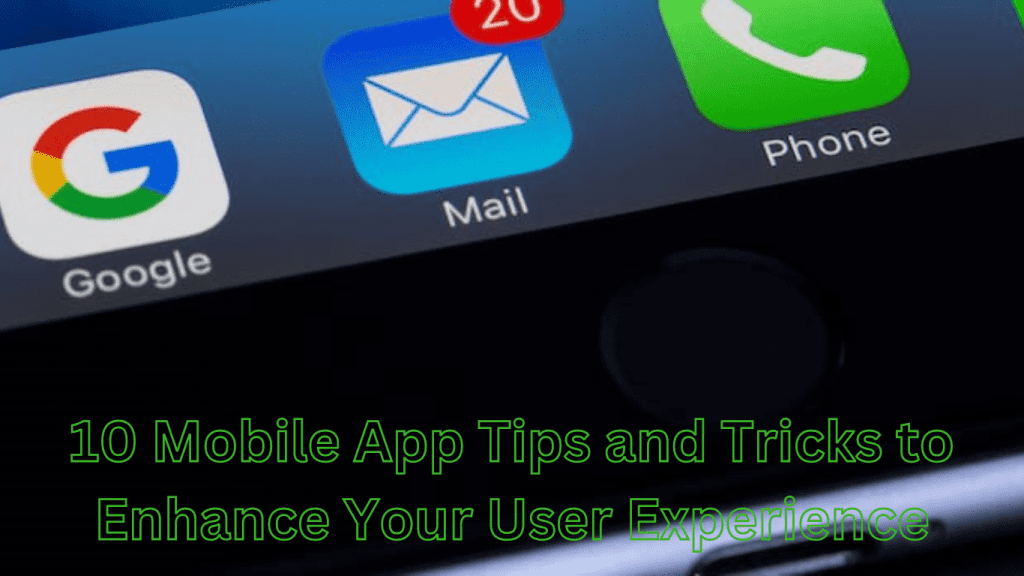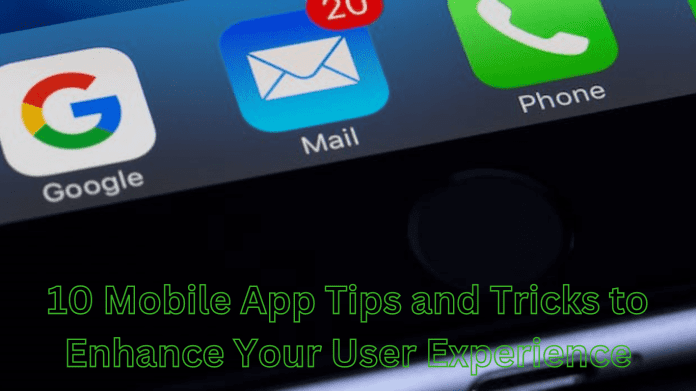Table of Contents
A meta description is a succinct synopsis or explanation of a webpage’s content. The meta description of a mobile app gives a brief synopsis of the main functions and features of the program. It aids customers in comprehending the purpose of the program and what to anticipate when utilizing it. An effective meta description can be very important for drawing in new visitors and persuading them to download and interact with.
1. Understanding the Importance of Mobile App Tips and Tricks
1.1. Accessibility and Convenience: Mobile apps provide quick and simple access to products, services, and information. Users may access them at any time and from any location, making for a seamless and customized experience.
1.2. Enhanced User Experience: Mobile apps are designed specifically for mobile devices, which allows for optimized user interfaces and smooth interactions. They leverage device capabilities such as touch screens, GPS, cameras, and push notifications to create a more engaging and immersive user experience.
1.3. Branding and Recognition: Creating a mobile app including your brand’s features and logo can help people recognize and see your brand more. It forges a clear line of communication between your company and its customers, forging a powerful brand identity in the mobile market.
1.4. Personalization and Targeted Marketing: Mobile apps employ user data, including location, behavior, and preferences, to provide individualized experiences. This boosts consumer engagement and increases conversion rates by enabling tailored recommendations and targeted marketing campaigns.
1.5. Utilize Push Notifications: Push alerts are a useful tool for maintaining user awareness and engagement. If you want to promote app usage and improve customer retention, you can send out timely updates, offers, or notifications. To prevent annoying users, it’s crucial to use push notifications sparingly.

2. Exploring Mobile App Hacks for an Enhanced User Experience
2.1. Simplify Onboarding: Make the onboarding process quick and straightforward. Avoid asking for excessive permissions or overwhelming users with too much information upfront. Provide a clear value proposition and guide users through the most critical features of your app.
2.2. Implement Intuitive Navigation: Design a user-friendly navigation system that is intuitive and easy to use. Use standard UI patterns and place important actions within thumb reach for easy access. Consider implementing bottom navigation bars, swipe gestures, or a floating action button for commonly used actions.
2.3. Personalize Content and Recommendations: Leverage user data and preferences to personalize the content and recommendations within your app. Show relevant products, articles, or suggestions based on users’ past behavior, locations, or interests. This personalization can significantly enhance the user experience and increase engagement.
2.4. Implement Offline Capabilities: Permit users to access specific features and content of the app when offline. Applications that allow users to consume content or rely on real-time data would greatly benefit from this. Give users the option to save content for offline viewing, caching systems, and offline consumption.
2.5. Enable Push Notifications: Implement push notifications to keep users informed about important updates, new features, offers, or personalized recommendations. However, be mindful not to spam users with excessive notifications. Provide users with control over their notification preferences.
2.6. Implement Dark Mode: Dark mode is a popular feature that reduces eye strain and enhances readability in low-light conditions. Adding a dark mode option can improve the visual aesthetics and accessibility of your app.
3. Unveiling the Best Mobile App Tricks Used by Experts
3.1. Simplified Onboarding: Users should quickly understand how to use your app. Implement a streamlined onboarding process that introduces key features without overwhelming users. Keep it concise and interactive to maintain user interest.
3.2. Performance Optimization: Optimize your app’s performance to ensure fast loading times, smooth animations, and minimal crashes or errors. Utilize caching, compression, and lazy loading techniques to enhance speed and efficiency.
3.3. Personalization: Include customization options that allow the app to be tailored to the tastes and usage patterns of specific users. Custom settings, adaptable interfaces, and tailored content recommendations are a few examples of this..
3.4. Offline Functionality: Permit users to use specific app functions or content even when they are not online. This can include offline modes for document editing and reading as well as offline interactive games and utilities that don’t need internet access.
3.5. Integration with Device Capabilities: Leverage device capabilities like GPS, camera, microphone, and sensors to create unique and engaging experiences. For example, incorporate location-based features, image recognition, or voice commands.
3.6. Push Notifications: Use push notifications strategically to keep users engaged and informed about updates, important events, or personalized offers. Make sure the notifications are relevant and add value to the user experience.
3.7. Social Media Integration: To facilitate simple sharing, social login, or social connections, integrate your software with well-known social networking networks. This has the potential to boost user involvement, promote viral expansion, and offer customized social interactions.
3.8. A/B Testing: To improve the performance and user engagement of the app, test various features, design components, and user flows on a regular basis. Get input from users and evaluate data analytically to create data-driven decisions for enhancements.


4. Effective Mobile App Tricks to Optimize Performance
4.1. Efficient Coding Practices: Write clean, efficient, and modular code. Optimize algorithms and data structures to minimize resource usage. Use adequate design patterns and follow coding best practices to maximize performance.
4.2. Network Optimization: Minimize network requests by merging data and reducing unnecessary API calls. Implement caching mechanisms to store frequently accessed data locally, reducing dependence on the network. Use compression techniques like GZIP to reduce data transfer size.


4.3. Background Processes: Carefully manage and prioritize background processes to avoid excessive battery drain and CPU usage. Limit the frequency of background refreshes and perform resource-intensive tasks only when necessary.
4.4. Resource Management: Make effective use of the system’s resources. As soon as possible, disconnect any unnecessary connections and free up RAM. Prevent memory leaks and needless resource hoarding to prevent program slowdowns or crashes.
4.5. Multithreading and Asynchronous Operations: Utilize multithreading and asynchronous programming to handle time-consuming or blocking tasks. Offloading non-UI tasks to background threads keeps the user interface responsive and ensures a smooth user experience.
4.6. Test and Optimize UI Responsiveness: Regularly test your app’s UI responsiveness across different devices and user scenarios. Optimize UI rendering by avoiding excessive UI updates or expensive layout calculations. Use tools like the Chrome Dev Tools Performance tab or Android Profiler to identify and address UI bottlenecks.
4.7. Optimize Battery Consumption: Minimize battery consumption by optimizing CPU usage, reducing network requests, and using efficient background processing. Avoid unnecessary wake locks or continuous location updates that drain the battery unnecessarily.
5. Discovering Hidden Features: Mobile App Secrets Revealed
5.1. Long Press Actions: Many apps have long-press actions that provide additional functionality. Try long-pressing on buttons, icons, or text to see if any hidden features or shortcuts are revealed.
5.2. Gestures and Shortcuts: Verify whether the software allows for custom shortcuts or gestures. For instance, certain finger movements, pinching, or left- or right-swiping gestures may cause instantaneous or hidden functions.
5.3. Easter Eggs: Some app developers include hidden Easter eggs as fun surprises for users. Look for hidden animations, secret buttons, or unexpected interactions that unlock hidden features.
5.4. Voice Commands: Verify the compatibility with virtual assistants such as Google Assistant, Siri, or Alexa, as well as its capability for voice requests. By just giving a command, you could be able to carry out operations or gain access to secret functionalities.
5.5. User Communities and Forums: Participate in user-run forums or communities for the app you’re using. Frequently, other users provide hints and information regarding unidentified features or secret capabilities.
6. Streamlining User Experience with Mobile App Shortcuts
6.1. Identify Key Features: Determine the most frequently used features or actions within your app that users would benefit from accessing quickly. These could be commonly used actions, important sections, or frequently accessed content.
6.2. Support Gesture-Based Shortcuts: For devices that support gesture-based navigation, consider implementing gesture shortcuts in your app. This could include swiping gestures from specific directions or using long-press actions for quick access.
6.3. Offer Contextual Shortcuts: Consider providing contextual app shortcuts that adapt to the user’s behavior or context. For example, you can display shortcuts to recently viewed documents, frequently contacted friends, or recommended articles based on user preferences.
6.4. Prioritize User Feedback: Gather feedback from users about which features or actions they would like to access through shortcuts. Conduct user surveys, monitor support channels, or analyze user behavior to identify popular requests and prioritize them for shortcut implementation.
7. Enhancing User Experience through Mobile App Optimization Tricks
7.1. Smooth Navigation: Provide effective and user-friendly navigation flows to enable users to navigate between app parts with ease. Make navigation simple to use and understand by using clear labels, icons, and gestures.
7.2. Responsive Design: Make a design that can adjust to various screen sizes and orientations by making it responsive. This will guarantee that the application runs smoothly and looks beautiful across all platforms, offering a uniform user experience.
7.3. Simplify Registration and Login: Streamline the registration and login process by offering social media logins or implementing biometric authentication options such as fingerprint or face recognition. This reduces friction and makes it easier for users to access your app.
7.4. Error Handling and Feedback: Provide clear and meaningful error messages when something goes wrong. Use descriptive language, offer helpful suggestions, and provide a way for users to report issues. This demonstrates that you care about their experience and helps them troubleshoot problems easily.
7.5. Personalization: Implement personalized features and content recommendations based on user preferences, behaviors, or previous interactions. This creates a more tailored experience and encourages users to engage with your app.
7.6. Push Notifications: Use push notifications sparingly and thoughtfully to provide timely and relevant information to users. Personalize notifications based on user preferences and behaviors, and allow users to easily customize their notification settings.
7.7. User Testing and Feedback: Continuously gather feedback from users through surveys, ratings, or reviews. Regularly conduct user testing sessions to understand pain points, identify areas for improvement, and prioritize app optimization efforts based on user insights.
7.8. Regular Updates and Bug Fixes: Release regular updates to address bugs, introduce new features, and improve overall app performance. Promptly addressing user-reported issues demonstrates your commitment to providing an optimal user experience.
8. Customizing Your Mobile App: Tips and Tricks for Personalization
8.1. User Preferences: Allow users to customize various aspects of the app, such as theme, font size, color schemes, or layout options. Provide settings or preferences where users can easily modify these elements to suit their preferences.
8.2. User Profiles: Include user profiles so that users can register for unique accounts or profiles within your Petition. As a result, consumers may get personalized material, track their behavior, and preserve preferences.
8.3. Customizable Widgets or Dashboards: Offer customizable widgets or dashboards that users can configure according to their needs. This allows them to display relevant information or frequently used features at a glance.
8.4. Personalized Recommendations: Use algorithms and data analysis to provide personalized recommendations based on user behavior, preferences, or past interactions. This could include recommended products, articles, playlists, or suggestions for similar content.
8.5. Contextual Notifications: Send contextual notifications that are specific to each user’s interests or activities. Avoid generic or irrelevant notifications and instead focus on delivering personalized messages that engage users with relevant information or updates.
8.6. Location-Based Personalization: Leverage location data to provide personalized recommendations or features that are specific to a user’s location. This could include localized offers, nearby points of interest, or customized content for a particular city or region.
8.7. Sync Across Devices: Enable users to synchronize their app settings, preferences, or saved content across multiple devices. This ensures a consistent experience and convenience when switching between devices.
8.8. Social Integration: Allow users to connect their social media accounts. This enables them to share content, see friends’ activity, or discover popular trends that align with their interests.
9. Boosting Productivity with Mobile App Productivity Tricks
9.1. Create Productive Habits: To build and sustain productive habits, use habit-tracking Petition like Loop or Halitic. Establish daily objectives, monitor your advancement, and get rewarded for reliably finishing assignments.
9.2. Set Reminders and Notifications: Make use of the notifications and reminders provided by your productivity apps or calendar. To help you remember things, set up reminders for meetings, deadlines, and recurring tasks.
9.3. Enable Productivity Features: Examine the operating system’s built-in productivity capabilities on your smartphone or download specialist. For instance, turning on Screen Time on iOS or enabling Focus Mode on Android can assist increase focus and reduce distractions.
9.4. Utilize Keyboard Shortcuts: Take advantage of keyboard shortcuts available in apps or through third-party keyboard. This can speed up typing, navigation, and other tasks, saving you time and effort.
10. Innovating Your User Experience: Unique Mobile App Tricks
10.1. Gamification: Integrate game elements into your app to make it more interactive and engaging. This could include adding rewards, progress trackers, leaderboards, or challenges that encourage users to continue using your app.
10.2. Augmented Reality (AR): Utilize AR technology to create immersive experiences within your app. This could involve overlaying virtual objects in the real world, offering virtual try-on features, or providing interactive 3D content.


10.3. Voice Interaction: Add voice recognition functionality to your Petition so that users may communicate with it by speaking commands into it. This can facilitate hands-free use, enhance accessibility, and simplify navigation.
10.4. Offline Functionality: Implement offline capabilities that enable users to access certain features or content even when they don’t have an internet connection. This can include offline caching, saving data locally, or providing offline editing options.
10.5. Intelligent Chatbots: Integrate smart chatbots that use artificial intelligence to provide personalized recommendations, answer user queries, or offer assistance. This can enhance customer support and provide real-time interaction.
10.6. Dynamic Theming: Allow users to customize the theme of your app by offering a range of themes or allowing them to choose their own colors, backgrounds, or layouts. This gives users a sense of ownership and personalization.
10.7. Personalized Onboarding: Create a personalized onboarding experience for new users that takes into account their goals, interests, or preferences. Tailor the onboarding process to guide users to the features that are most relevant to them.
10.8. Contextual Reminders: Use push notifications or reminders that are triggered based on specific user actions or behaviors. These reminders can help users stay on track, complete tasks, or take advantage of time-limited offers.
10.9. Social and Community Integration: Integrate social sharing capabilities within your app to allow users to easily share content, achievements, or experiences with their social networks. Implement community features such as user forums, discussion boards, or user-generated content.
Powered by Bestwritebot.com , Otips , Free Video Downloader , softwarestore , free online game hub


